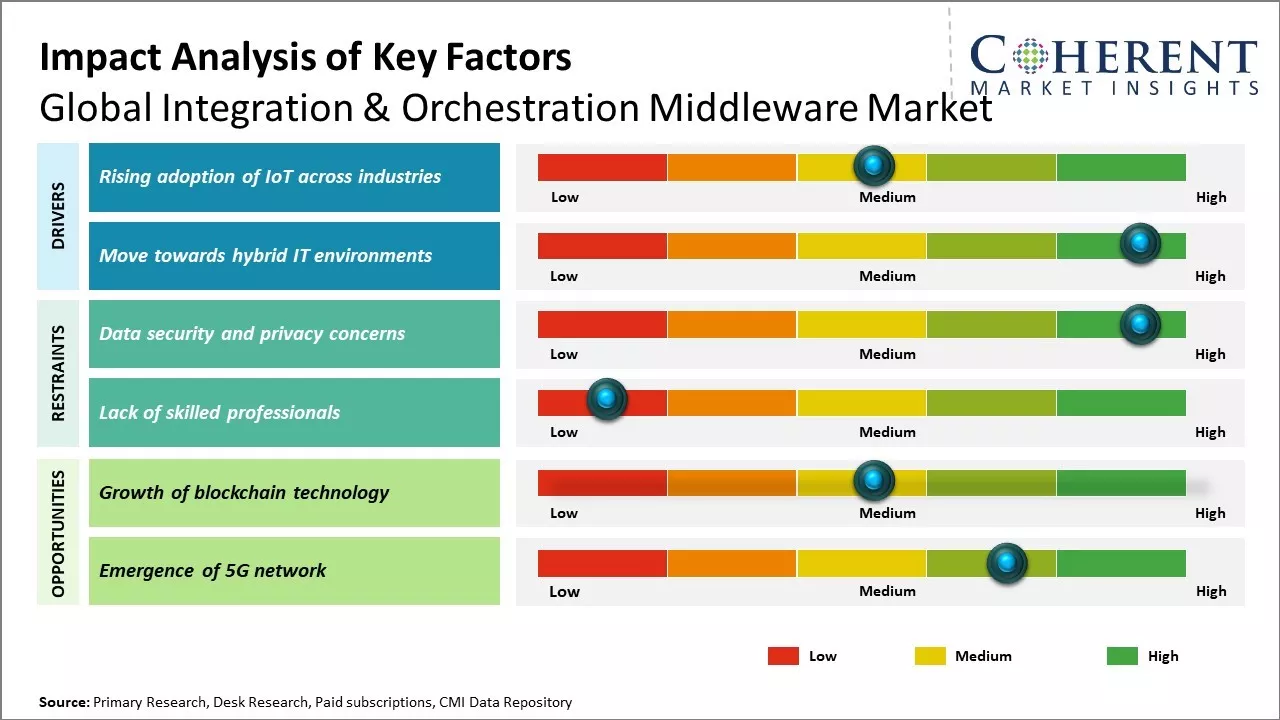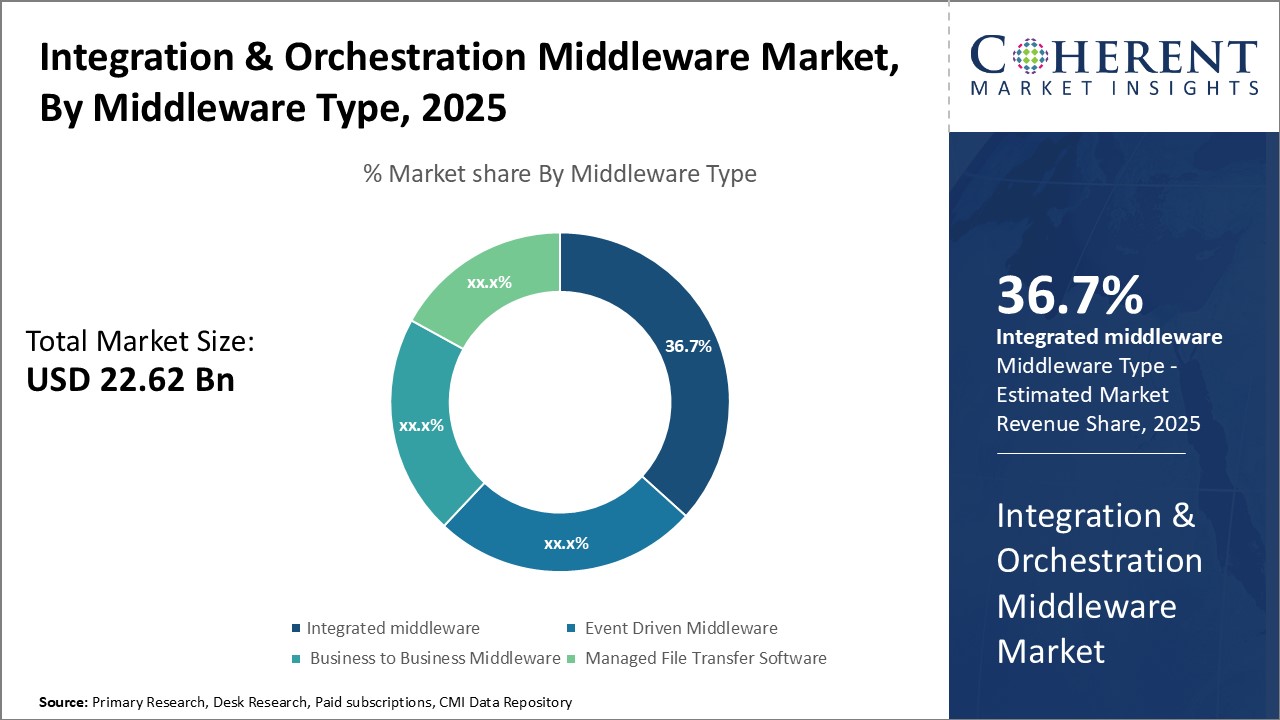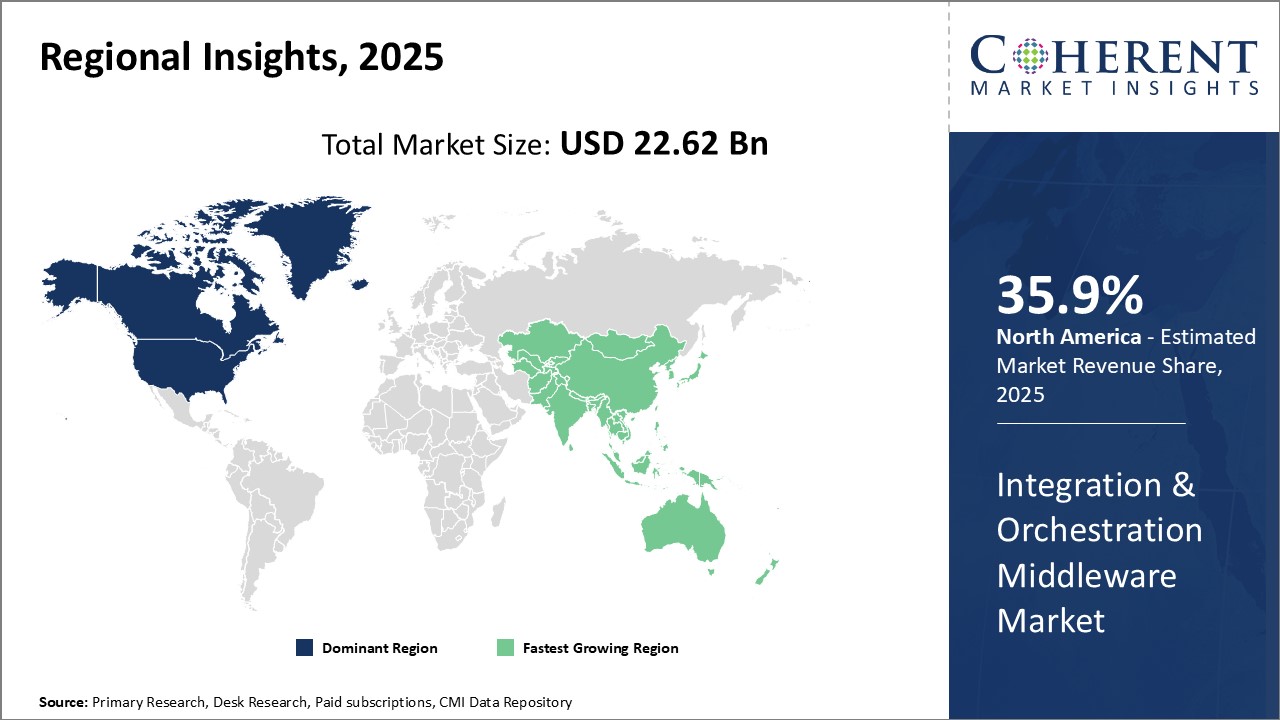
The global integration & orchestration middleware market is estimated to be valued at US$ 22.62 Bn in 2025 and is expected to reach US$ 33.81 Bn by 2032, exhibiting a compound annual growth rate (CAGR) of 5.9% from 2025 to 2032.

Discover market dynamics shaping the industry: Download Free Sample
The global integration & orchestration middleware market is expected to witness significant growth over the forecast period. Factors such as growing adoption of cloud-based middleware solutions and emerging technologies like microservices are expected to drive the market growth. Additionally, increasing demand for Application Programming Interface (API) management, application integration, and B2B integration across industries is further augmenting the demand. Growing digital transformation initiatives by companies and increasing connectivity through Internet of Things is also contributing to the market growth. The market players are investing in innovations and new product development to strengthen their market position.
For instance, in 2023, IBM, an American multinational technology company planned to launch a new cloud-based hybrid integration platform with enhanced API management capabilities. However, data privacy & security concerns related to cloud-based services may hinder the market growth.
Rising adoption of IoT across industries
The growing adoption of Internet of Things (IoT) solutions across industries is opening up new opportunities for integration and orchestration middleware. IoT connects numerous physical devices like sensors, healthcare devices, industrial devices, and others to the internet. This generates vast amounts of data that needs to be transferred, processed, and analyzed for extracting valuable insights. Integration and orchestration middleware helps in seamlessly connecting different systems, databases, and applications for enabling data exchange between IoT devices and various other IT systems. It facilitates real-time data integration from diverse endpoints and orchestrates different tasks and workflows for the smooth operation of the IoT infrastructure.
Several industries are implementing IoT at a massive scale to optimize business processes, improve productivity, and offer enhanced customer experiences. For example, smart manufacturing is leveraging IoT sensors on machines for predictive maintenance, remote monitoring and upgrading production lines. Similarly, connected healthcare is benefiting from IoT-enabled medical devices, remote patient monitoring systems and electronic health records. Integration middleware plays a pivotal role in these implementations by allowing bi-directional data exchange between different IoT components, cloud platforms, data lakes, and analytics systems. It manages high data volume and variety in real-time while ensuring reliability, security, and scalability of IoT infrastructure. As more industries digitally transform, the demand for integration middleware that can seamlessly tie together multifaceted IoT deployments will significantly increase in the coming years.
For instance, in September 2020, Oracle, designs, manufactures, and sells both software and hardware products and offers services that complement them (such as financing, training, consulting, and hosting services) announced the integration of Oracle Integration Cloud (OIC) with Oracle Autonomous Database, further enhancing the capabilities of Oracle's cloud-based integration platform.

Get actionable strategies to beat competition: Download Free Sample
Move towards hybrid IT environments
In the current digital era, organizations are adopting hybrid IT models to leverage the power of both on-premises and cloud-based systems simultaneously. This brings together the scalability, flexibility and cost benefits of cloud with security and control advantages of on-premises infrastructure. However, managing hybrid environments poses unique integration challenges due to complex technology landscapes that span physical and virtual systems, private and public clouds as well as legacy and modern applications. This is where integration and orchestration middleware become indispensable. It provides comprehensive tools and capabilities for enabling seamless data exchange, streamlined workflows, and unified management across different environments.
Some key roles played by integration middleware include data mapping and transformation, API management, monitoring, routing tasks between distributed systems and building microservices. This helps bridge the gap between on-premises data centers and multi-cloud platforms.
Key Takeaways from Analyst:
The global integration & orchestration middleware market continues to grow steadily as enterprises across all industries are recognizing the need to better integrate their on-premise and cloud-based applications and data sources. The ability to share data seamlessly both internally and with partners/customers is becoming a key competitive differentiator.
North America currently dominates the market owing to the early adoption by financial services and retail firms. However, the Asia Pacific region is expected to experience the fastest growth in adoption over the next five years as more companies digitalize their processes and infrastructure. China, Japan, and India will be the major driving markets especially in the logistics, manufacturing, and consumer goods sectors.
Europe is also anticipated to see increasing investments to meet stringent compliance requirements and allow for cross-border collaboration driven by digital transformation initiatives. Financial constraints due to economic uncertainties remain a challenge but are being addressed through pay-per-use pricing models.
Technological capabilities around API management, microservices architecture, integration platform as a service, and process automation continue to expand integration opportunities across government, healthcare, and utilities. Meanwhile, security concerns around data privacy and compliance represent an ongoing restraint area that vendors must adequately address to further boost the market share.
Market Challenges: Data security and privacy concerns
Data privacy and security concerns are presenting significant challenges for the growth of the global integration and orchestration middleware market. With organizations increasingly dealing with highly sensitive data such as financial information, healthcare records, intellectual property, etc., concerns around unauthorized access to such data and potential data breaches have escalated tremendously in recent years. Integration and orchestration middleware solutions are aimed at facilitating secure exchange and optimal utilization of data across different applications, systems and businesses. However, the complexity of these solutions and the risk of vulnerabilities also increases possibilities of data theft or leakages.
Recent cyber-attacks and data breaches at large corporations like Yahoo, Equifax, and Marriott among others have severely dented customer trust and highlighted risks around unsecured data flows. This has made organizations highly skeptical of adopting new middleware solutions without stringent assurance of privacy and protection.
Market Opportunities: Growth of Blockchain technology
Blockchain technology has the potential to revolutionize how integration and orchestration middleware solutions are built and delivered. By leveraging the transparent and immutable nature of Blockchain ledgers, middleware providers can develop applications that facilitate highly secure communication and data sharing between diverse software systems. This addresses a key challenge in the existing middleware arena around lack of trust and interoperability between different networks and platforms. As cross-industry and cross-border data exchange increases in scale and complexity due to trends like digital transformation, Internet of Things (IoT), and open banking, the demand will surge for middleware solutions incorporating Blockchain's decentralized approach.
By implementing Blockchain, middleware players can offer their clients a shared record of asset ownership and transactions that persists across organizational boundaries. This allows for automated processing and auditing of workloads as well as guaranteed execution of processes according to established rules. Various pilot projects underway indicate that middleware leveraging Blockchain results in significant gains like reduced operating costs, improved resilience to cyber threats, near real-time information availability, and simplified compliance with regulatory frameworks.

Discover high revenue pocket segments and roadmap to it: Download Free Sample
Insights By middleware type - Growing Need for Automation in Enterprise Integration
In terms of middleware type, business to business middleware is expected to contribute 36.7% share of the market in 2025 owing to the growing need for automation in enterprise integration processes. Business to business middleware allows seamless communication and data exchange between businesses by facilitating interoperability. With increasing business operations and partnerships across geographical locations, there is a rising demand to streamline B2B interactions and make processes more efficient. B2B middleware provides a centralized platform to manage sales, procurement, logistics and other inter-company transactions digitally. This has significantly boosted productivity and optimized costs for businesses. The solution also enables real-time tracking of orders, payments and inventory levels which is important for demand-supply management. With growing complexities in global supply chains, B2B middleware has become essential for smooth information flow between an enterprise and its customers as well as vendors.
Insights By deployment type - Cloud Adoption Spreads among Organizations
In terms of deployment type, cloud based is expected to contribute 54% share of the market in 2025 driven by the widespread adoption of cloud technologies among organizations. The flexibility and cost-efficiency of cloud deployment models have prompted businesses to migrate their IT infrastructure and applications to the cloud. Cloud-based middleware eliminates the need for expensive on-premise servers and software. It offers a pay-as-you-go pricing structure along with benefits like scalability, mobility and simplified maintenance. This has increased the popularity of Software as a Service (SaaS) as organizations no longer need to make high upfront capital investments. The ubiquitous access provided by cloud also supports remote working and business continuity. These advantages have accelerated the movement of middleware platforms to the cloud across industry verticals.
Insights By vertical - Healthcare sees Middleware as Critical Component
In terms of vertical, healthcare is expected to contribute 40.3% share of the market in 2025 owing to the vital role played by middleware in facilitating information exchange. Interoperability between diverse healthcare IT systems is crucial considering the complexity of electronic medical records, imaging data, prescribed treatments, and insurance claims processing. Middleware ensures the seamless flow of patient health information across multiple physician practices, laboratories, pharmacies, and insurance providers. It supports the efficient management of medical infrastructure, aids clinical decision making, and streamlines administrative functions. This enhances the quality of patient care while reducing costs. With rising healthcare digitization, integration middleware has become indispensable for healthcare providers to deliver centralized and coordinated care. Government mandates to shift records online also drive the adoption of healthcare middleware solutions.

Need a Different Region or Segment? Download Free Sample
North America has established itself as the dominant region in the global integration & orchestration middleware market. With a strong presence of major players and growing digital transformation initiatives across industries, North America accounts for over 35.9% of the market share in 2025. Large enterprises in the U.S. are making significant investments in middleware solutions to achieve seamless data exchange within various business units and with external partners. This has propelled the widespread adoption of middleware in North America.
The Asia Pacific region is emerging as the fastest growing market and is expected to see increased traction going forward. Countries like China, India, Japan, and South Korea are contributing to the high growth rate owing to rising digitalization spending and demand from small and medium enterprises. Asia Pacific businesses are moving towards integrated platform-based solutions to enhance collaboration and support new business models in this competitive landscape. Growing cross-border transactions and foreign investments in the region are further supplementing the need for effective data integration.
Japan has historically been a leader in middleware adoption with early investments in technologies like enterprise application integration. However, other South East Asian countries have narrowed this gap in recent times, fueled by expanding internet connectivity. China in particular is witnessing a surge owing to government initiatives for smart city development and support to domestic software companies. Growing exports market and consumerism levels have accelerated the pace of digital transformation in Asia Pacific economies over the past decade.
Overall adoption of middleware is relatively higher in the developed markets of North America and parts of Asia Pacific due to early exposure to advanced technologies. However, a thriving startup ecosystem and initiatives around digital skills in countries like India point towards significant latent demand in this region. Asian middleware providers are gaining prominence by establishing low-cost, localized solutions tailored for small and medium businesses. This will further boost the regional market as SMB sector continues to increase contributions to the overall economy.
Integration & Orchestration Middleware Market Report Coverage
| Report Coverage | Details | ||
|---|---|---|---|
| Base Year: | 2024 | Market Size in 2025: | USD 22.62 Bn |
| Historical Data for: | 2020 To 2024 | Forecast Period: | 2025 To 2032 |
| Forecast Period 2025 to 2032 CAGR: | 5.9% | 2032 Value Projection: | USD 33.81 Bn |
| Geographies covered: |
|
||
| Segments covered: |
|
||
| Companies covered: |
Axway, Boomi, Broadcom, Cisco Systems, Fujitsu, Hewlett Packard Enterprise, IBM, Informatica, Microsoft, MuleSoft, Oracle, Red Hat, SAP, Software AG, and TIBCO Software |
||
| Growth Drivers: |
|
||
| Restraints & Challenges: |
|
||
Uncover macros and micros vetted on 75+ parameters: Get instant access to report
*Definition: The global integration & orchestration middleware market provides software platforms and tools that help integrate various applications and systems within and across organizations, and coordinate people, systems, and business processes. It allows companies to connect and manage hybrid IT landscapes, as well as facilitate communication between applications and data sources across distributed and complex environments.
Share
Share
About Author
Monica Shevgan has 9+ years of experience in market research and business consulting driving client-centric product delivery of the Information and Communication Technology (ICT) team, enhancing client experiences, and shaping business strategy for optimal outcomes. Passionate about client success.
Missing comfort of reading report in your local language? Find your preferred language :
Transform your Strategy with Exclusive Trending Reports :
Frequently Asked Questions
Joining thousands of companies around the world committed to making the Excellent Business Solutions.
View All Our Clients